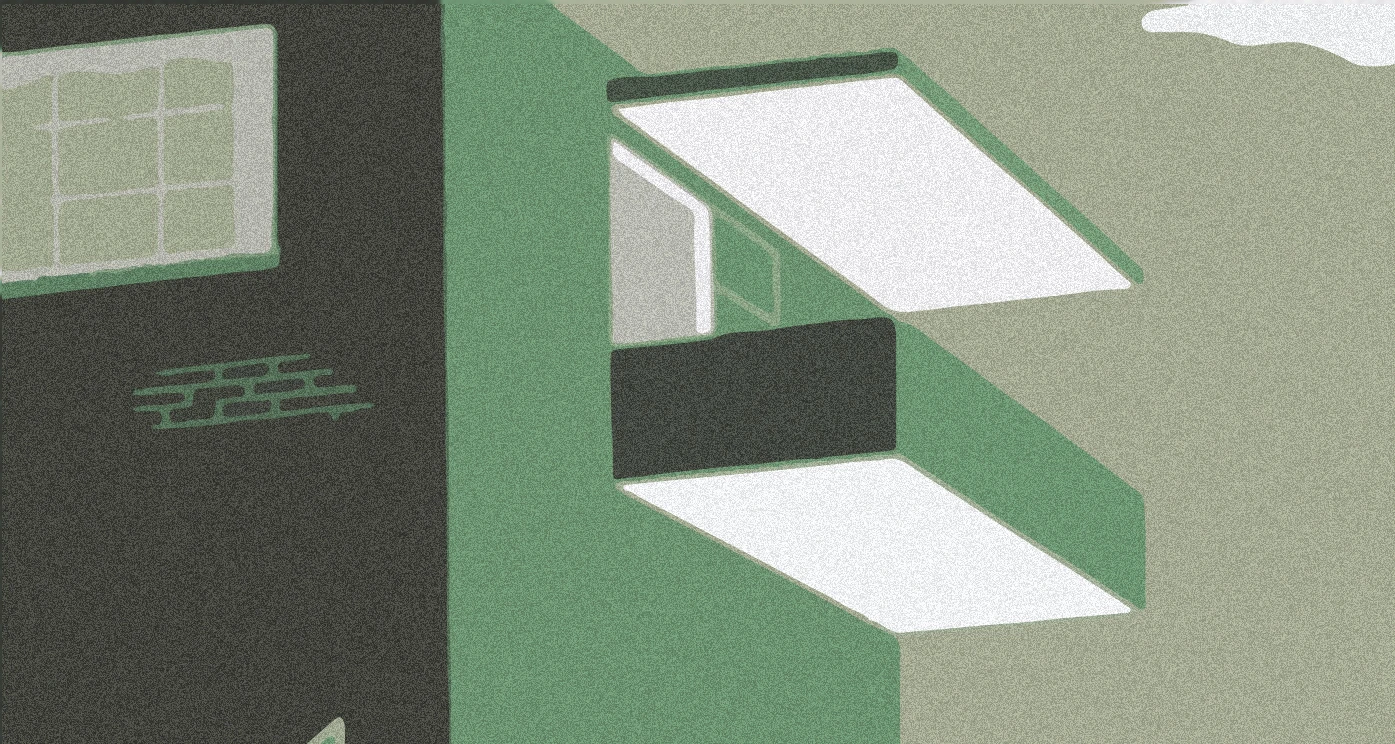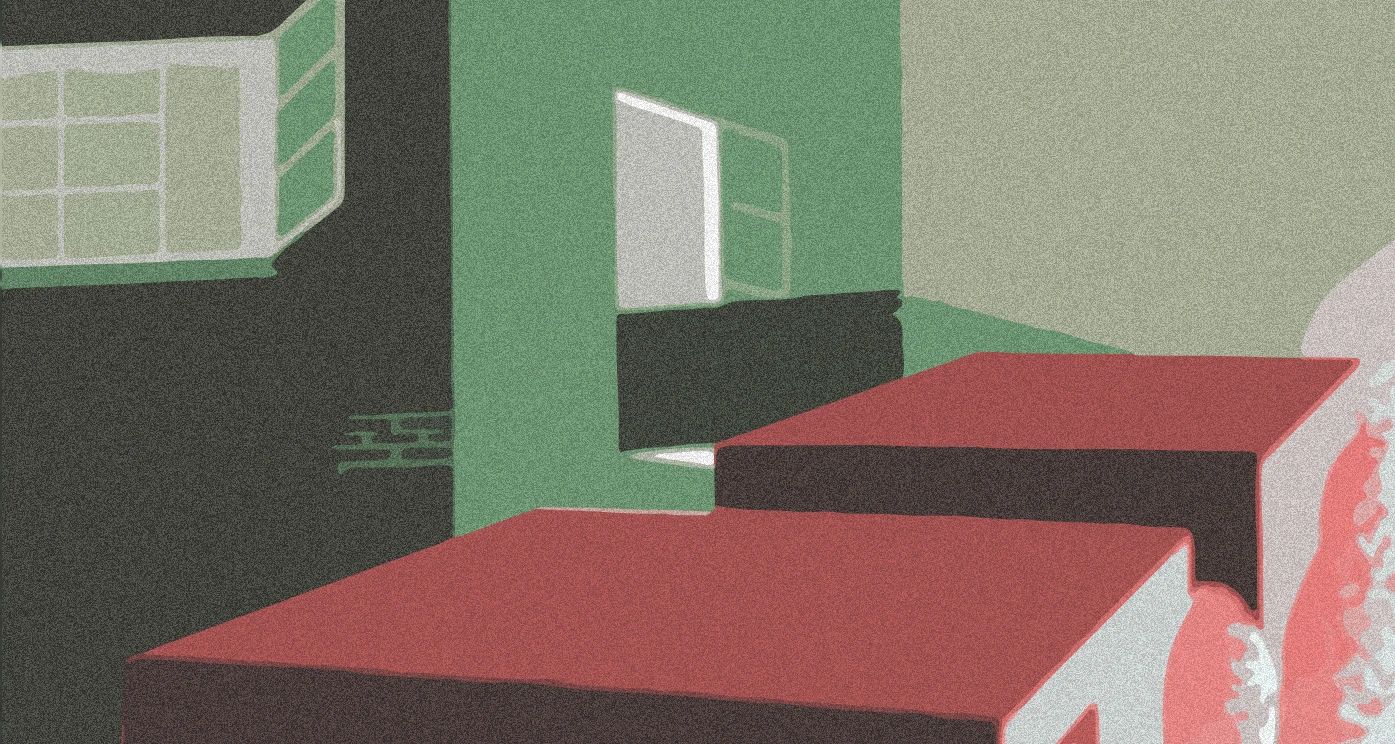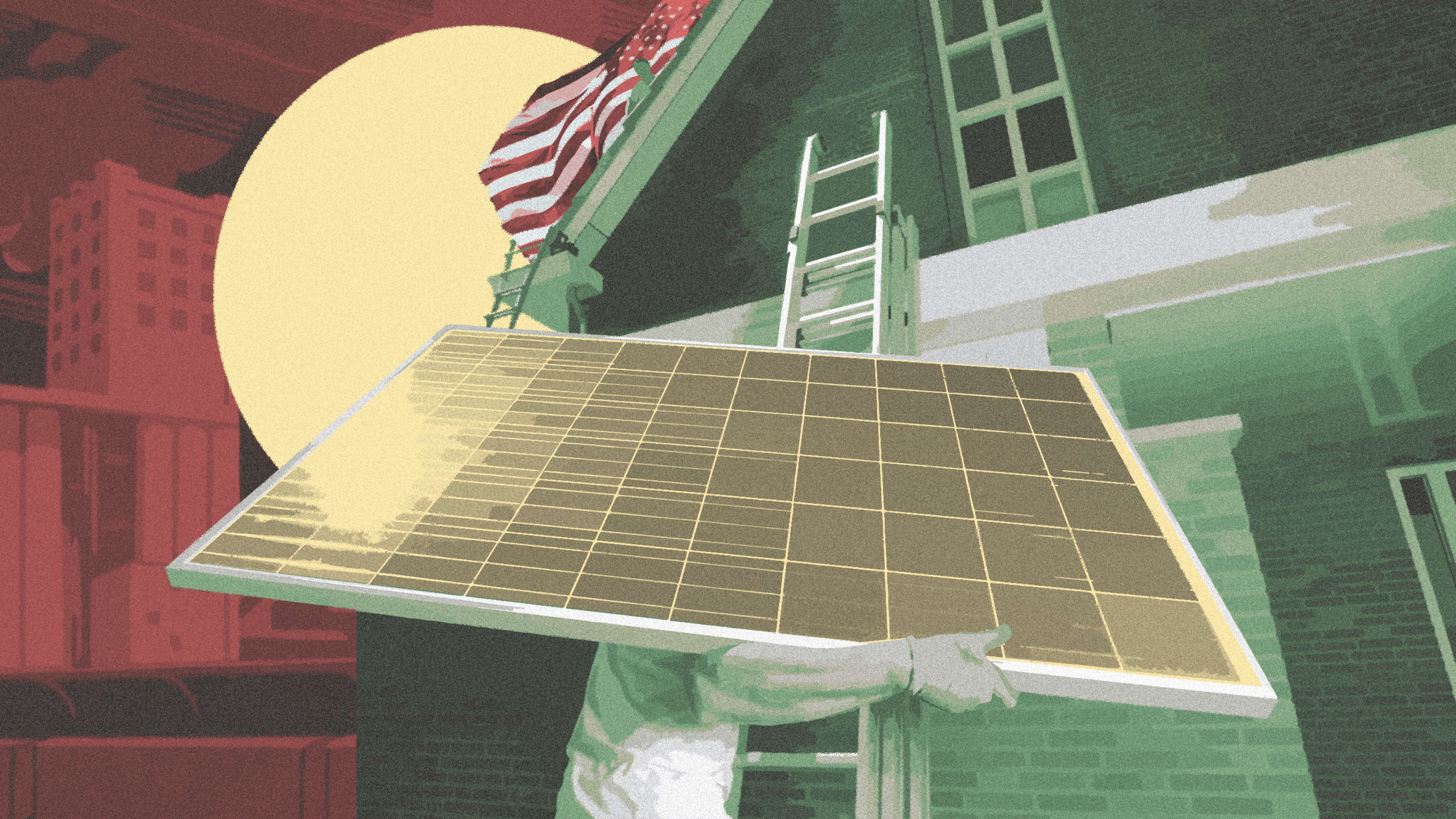Whether or not the U.S. decides to take action on climate change, the shape of the country—its towns, offices, homes, schools, roads, farms, and more—is on the brink of a radical transformation. This transformation could be borne out in two ways. The first is external: Escalating storms, floods, droughts, mass migration, food scarcity, and economic instability could dramatically alter the physical landscape and economy. The other is internal: A national effort to retrofit millions of buildings and rethink the way communities are designed could help Americans withstand the ravages of climate change and make the country more equitable.
The resolution known as the Green New Deal, published by Representative Alexandria Ocasio-Cortez and Senator Ed Markey in February, wants to bring about the latter. The Green New Deal framework describes the monumental changes needed to decarbonize the American economy by meeting 100% of our energy demands with zero-emission sources in the next decade. It will require overhauling major industries like energy and agriculture, but also transforming America’s buildings and construction sector.
It’s easy to miss just how destructive and inefficient land development is, given its ubiquity. Existing buildings hoover up about 40% of energy consumed in the U.S. and emit about 29% of greenhouse gases. The Green New Deal calls for retrofitting all of them—every last skyscraper, McDonald’s, and suburban ranch home—for energy efficiency within the next 10 years. It also addresses the role of the construction industry, which accounts for about 11% of all emissions globally, by recommending investment in community-led building projects oriented around decarbonization issues like resiliency, transit, and land preservation. And crucially, it demands family-sustaining wages, the right to organize, and a “just transition” for everyone affected by the transition to this decarbonized world.
This story is part of our series A Green New Deal for Business, looking at how the environmental and economic aims of the resolution might transform industries in the U.S. You can read more here.
House Republicans quickly declared the resolution a “boondoggle” in an official statement. It was an ironic choice of words. Whether the GOP realized it or not, that term emerged in the 1930s, when critics of the New Deal used it to characterize the project of putting broke Americans to work on hundreds of thousands of projects. It’s true that the Green New Deal’s goals—to reshape the country’s homes, workplaces, and economy, and provide equity for all—sound radical in a country ravaged by the housing crisis, worker exploitation, and stagnating wages, but from a technical, structural, and architectural standpoint, they’re entirely feasible. Despite what politicians would have you believe, we’ve done it before, and we have the tools to do it again.
As Rhiana Gunn-Wright, who is leading the creation of policy around the resolution, says, reaching them will mean thinking about transit, land use, housing, building regulations, and more. In short: “What will our cities and towns look like, moving forward?”

Designing a federal building project
According to the Energy Information Administration, there are roughly 5.6 million commercial buildings in the United States. Most of those are small; half are under 5,000 square feet—think of a fast food joint or a doctor’s office. There are also 138 million housing units, which includes both houses and apartment units. Reducing their carbon footprint will involve the crucial, economy-wide shift away from fossil fuels, but also tamping down the amount of energy buildings use in the first place.
Retrofitting tens of millions of houses and apartment buildings, which take lots of energy to heat, cool, and light, isn’t the Green New Deal’s most glamorous clause, but it’s one of its most pressing. As summers get hotter and the population (and thus the housing stock) grows, the urgency will only increase, as the Center for Climate and Energy Solutions reports. There will be trillions of lightbulbs to replace. Millions of HVAC units to upgrade, operable windows and automatic shades to install, rooftops to paint with heat-reflecting paint, shade-giving trees to plant and photovoltaics to hook up. Miles and miles of wiring and sensors and automation platforms to get online so it can all be monitored and controlled.
Who will do this work? Who will pay for it? How will it be regulated, in a country where building regulations are determined at local, rather than federal, levels? And perhaps most importantly, how will this work be done fairly at scale—for the workers who will need training to carry it out and contractors who will need help getting certified to do the work, but also for the millions of homeowners and renters who will be affected?
These are questions that Gunn-Wright is addressing in her role as policy director at New Consensus, the nonprofit that is now working to develop the Green New Deal. “The policy looks like a massive, federally led effort to upgrade all buildings and homes,” she says.
New Consensus is in the early days of this work, convening experts and studying potential policy strategies, so it’s too early to say exactly what shape that effort will take. It could establish a federal energy efficiency policy that acts like a baseline for what local building codes across the country must meet or exceed. Or, a federal program could work with states to encourage them to raise their energy standards locally through grant-making, Gunn-Wright explains. She also points to the promising emergence of prefabricated kits that make it easier and less expensive to retrofit homes to net-zero energy standards. A private-public project in the Netherlands has developed a prefab kit that transforms older public housing into net-zero homes in just a week—and pays for the work using the tenants’ eliminated energy bills.
Whatever shape this and other Green New Deal building projects take, it will involve a crucial focus on making sure workers, contractors, and homeowners aren’t burdened by it. “We have to be thinking about the potential adverse or unintentional consequences of doing these sort of upgrades, particularly for low-income families,” Gunn-Wright says.
Peggy Deamer—architect, Professor Emeritus of Architecture at Yale University, and founder of the Architecture Lobby—similarly cautions that Green New Deal policy will need to avoid avenues that emphasize technological solutions over the people affected by them. “Technology is essential in this, but [so is] making sure the technology is not seen as some utopian solution that leaves behind workers or decision-makers,” she says.

Building equity into the conversation
That’s a significant concern that the building industry will have to contend with as it modernizes. A renovation program on this scale could have many unintended effects. Gunn-Wright points out that energy upgrades can increase a home’s value and thus its property taxes, potentially pricing some owners out of their longtime homes. Likewise, all of these renovations could expose bigger structural or safety problems in the housing stock, putting an even greater burden on low-income families or those in public housing. “How are we taking care of those folks?,” Gunn-Wright asks. “And also beyond those folks, what does this next generation of affordable housing look like? Because housing policy clearly hasn’t led to enough affordable housing.”
New Consensus is now studying these issues, and there are many possible ways policy could address them. For instance, it could involve exempting low-income homeowners from property taxes in some form after their homes are upgraded under the program. A renovation program could also involve harmonizing the timing of energy upgrades to other federally funded programs for lead abatement and low-income housing improvements. “People think about personal intersectionality,” says Gunn-Wright, “but structures intersect too.”
Very quickly, the conversation becomes much bigger than energy renovations. “Yes, buildings are a significant source of emissions,” Gunn-Wright says, and that makes them a necessary facet of the Green New Deal. But “housing is also one of the main sources of wealth for communities of color, particularly black and Latino communities and especially black communities, so any investment in homes could also be one of the mechanisms for wealth creation in terms of equity,” she adds. “That’s another reason that we think about housing a lot—because if you are not thinking about housing, you are essentially saying, ‘I’m not thinking about the main driver of wealth for some of the most marginalized communities.'”
In this sense, the Green New Deal offers policymakers a rare, once-in-a-generation chance to rethink housing in America—to revive a conversation that was snuffed out, slowly but surely, over decades of defunding and disinvestment that began not long after the New Deal ended.

Modernizing the blueprint of the 1930s
The last time America’s building sector underwent this kind of mobilization was during the Great Depression, when millions Americans went to work for then-President Franklin Delano Roosevelt’s Works Progress Administration. The WPA saw by some counts, more than 125,000 buildings and 650,000 miles of roads built by workers, architects, and engineers. It was one of a collection of federal agencies, often called the “alphabet agencies,” created to oversee the New Deal and its large-scale changes to the country’s buildings, homes, airports, bridges, and roads. It lasted for almost a decade, before being cut in 1943 as the country prioritized wartime manufacturing and defense funding.
The way the Green New Deal might be administered is still an open question. After all, it’s a resolution, not concrete policy. Could some of those New Deal-era agencies be reborn as tools for leading the projects of the Green New Deal? It’s an idea that Billy Fleming, director of the Ian L. McHarg Center at the University of Pennsylvania’s Stuart Weitzman School of Design, explores in a recent essay in Places. The Green New Deal is “the biggest design idea in a century,” he wrote at the time, concluding, “whatever form the Green New Deal eventually takes, it will be realized and understood through buildings, landscapes, and other public works.”
The resolution may also be a chance for architects and designers in general to reclaim some agency in the work they do, after decades of being relegated to working for private developers.
“We’re going to need to do many different things in terms of injecting design expertise into the federal bureaucracy,” says Fleming, who worked on policy in the Obama administration. “Some of that will involve simply just creating more pathways for designers coming out of graduate school to take jobs in the federal government that are already there,” he explains, including roles at existing agencies like HUD, the DOT, the EPA, and others. “It will also mean reimagining what some of the special-purpose agencies of the New Deal-era would look like if they were attuned to climate change in the 21st century,” he continues. “You can imagine them taking on the big, spatial projects of climate adaptation and decarbonization in ways that our bureaucracy is not really set up to do.”
Take the Resettlement Authority, which Roosevelt created in 1935 to relocate Americans in Dust Bowl regions to more livable communities. “The Resettlement Authority was a relatively short-lived piece of the New Deal, and turned into other things as time went on,” Fleming explains. He imagines repurposing a version of it to deal with the managed retreat and relocation of millions of climate refugees. The RA could take on the task of not only “resettling people who are already here and will be forced to move as climate change disrupts the viability of living in many of these places,” he says, but also managing “the mass intake of people coming from all over the world fleeing the climate crisis.”
Realizing the Green New Deal will require the help of design professionals in other areas that touch land use, too. Urban planners might enter civil service to help amend building codes to allow denser development and the infill of backyards and garages with small rental apartments. Architects might join public works projects prototyping net zero affordable housing across the nation. Engineers might join regional authorities to help mitigate large-scale flooding and the relocation of farmers from increasingly waterlogged regions—and perhaps design ways to help people remain in place.
The Architecture Lobby was cofounded by Deamer in 2013 to organize for equity within the profession. The group has been a vocal proponent of the Green New Deal, publishing a call to action for architects to rethink the way buildings are designed, built, and financed through the lens of decarbonization. The resolution poses an opportunity for architects and designers to reclaim their relevance to society, not as service providers for wealthy clients but as vocal leaders on major issues in the built world, like social justice and climate change. “We have to indicate that even if we, for whatever reason, have been marginalized, and most of our work is for private developers, and we haven’t been called to the table for social problems like housing or ecology—that is because we haven’t spoken up,” Deamer says. “We have to speak up.”
Neither she nor Fleming are waiting around to do so. In September, a conference at Penn called Designing a Green New Deal, coorganized by Fleming, will bring together policymakers like Gunn-Wright, architects like Deamer, and journalists and activists like Naomi Klein and Kate Aronoff for a daylong series of panels and discussions about the resolution. “The entirety of the built environment is at stake,” the organizers write. “And the design professions—for all of their self-important rhetoric about leading on climate—are missing in action.”

A new opportunity for labor
Achieving the sweeping design and building projects that the Green New Deal calls for will also require a reconsideration of the labor force, and how to support it. Labor is the crux of nearly every project and goal in the Green New Deal: In the framework, ambitious building goals are presented right along with the guarantee of a job and paycheck that can support a family, and with Americans’ right to organize and have agency in their work.
These two things—labor and building—are impossible to separate. Buildings can be inscribed with injustices, like segregation or marginalization, and they can also act as a tool to mediate those forces, empower people, and bolster labor power.
One of the ways the building industry could help energize and support good labor under the Green New Deal is through the building retrofit program it may spur. A recent report on clean energy jobs from the Brookings Metropolitan Policy Program found that workers in these jobs, including those in the building industries, make significantly higher and more equitable wages compared to other Americans. As coauthor and fellow Adie Tomer explains, it’s still hard to say exactly how our collective response to climate change will affect labor, but the policy group is “confident that it will actually lead to more net jobs.”
However, a crucial part of growing the labor force around clean energy retrofits in the building industry is getting existing labor organizations on board. Working with labor unions is listed as a priority in the Green New Deal resolution, but some leaders like Richard Trumka, head of the national AFL-CIO, have expressed concern that unions were not incorporated enough into the planning process leading up to the release of the resolution. Union leaders would like to see more specific language around how organized labor can be incorporated as this job market expands.
The potential for this expansion is significant. A vanishingly small number of American building stock was designed with energy efficiency in mind, which means there are huge gains to be made from upgrades—gains huge enough that startups have already taken notice. Take Redaptive, a six-year-old company that operates on an extremely simple value proposition: It will not only pay for its clients’ energy retrofit, it will manage the project for them, too. The company then takes a percentage of the cash its clients save on their energy bill. “We’ll pay for all of the costs of this upgrade [because] the savings attributable to these upgrades and technology is big enough that there’s, frankly, enough to go around for everybody,” explains Redaptive co-CEO John Rhow, who was understandably “thrilled” by the release of the Green New Deal framework. The company, which raised a $20 million round of funding last year, estimates that the company has created 5,500 jobs across 44 states so far.
Redaptive and its competitors reflect the demand for expertise and workers, but the industry will need to tackle structural inequities if it is to meet the Green New Deal’s goals of inclusive, collaborative work. Tomer and his co-authors point out problems with diversity in this burgeoning clean energy workforce, which tends to be older, white, and male. Only 20% are women, and less than a tenth are black. They urge changes to school curricula, emphasizing STEM and offering apprenticeships and training programs, but also outreach on a local level. “Rooting out bias in key segments of the sector is a prerequisite for progress, as will be early inclusion, pre-apprenticeships, gender- or race-focused cohort strategies, and locally grounded neighborhood outreach,” they conclude.

Helping communities help themselves
Reducing the building industry’s carbon footprint will require structural changes at a national level, but local efforts to rethink both sustainability and labor in construction do exist. Take Babak Tondre, who cofounded the design-build cooperative Dig Cooperative in Oakland, California in 2003, with his co-owners, who felt that the construction industry model of a sole proprietor or corporate partnership “wasn’t offering a fair and equitable workplace for profit-sharing and decision-making by people in the field who may otherwise be more invested if they were able to have an opinion, or a place to express their ideas or ways of problem-solving or cutting costs in the field.”
He sees parallels between the resolution and the original New Deal, which built many of the Bay Area’s trails and parks in the region in the 1930s. “This Green New Deal is a similar idea to the Works Progress Administration,” he adds, “giving more people jobs in a local capacity to address their own micro-climate change issues—whether it’s flooding or drought.” Dig Co-op’s work, which specializes in sustainable water management, landscaping, and green construction, is informed by permaculture, a design ideology that places the emphasis on buildings as part of a larger natural ecosystem and the builder as part of a larger community. “It’s care for people, care for the earth, and a fair share for everyone,” he says. “We’re stewards, and we all live in this Bay Area, and this is my home and I’ve got to take care of it and leave it better for my kids,” he says. “That’s something I think could win the heart of the nation,” Tondre adds, “if we could all agree on it.”
It’s an ethos that falls closely in line with the Green New Deal’s emphasis on the trifecta of energy efficiency, cooperative labor, and investment in locally led projects. The trick, over the next few years, will be shaping the ambitious framework laid out by the resolution into policies—which will involve the effort of countless collaborators and stakeholders, and will likely face continued pushback from opponents. But the things it proposes are not unrealistic, especially from the vantage of the building industry. In fact, many of its building goals are clearly feasible from a technical, structural, and architectural standpoint.
“I’ve been really heartened by realizing just how much expertise and knowledge we have, and how much of this we already know how to do,” Gunn-Wright says. “It’s just a matter of aligning incentives, ensuring that folks will have the resources that are necessary, and making sure that we can structure it in a way that actually empowers communities that have been traditionally disempowered and creates a more equitable economy.”
And if we choose to do nothing, reasoning, as some have, that the Green New Deal is just too big? America will be transformed anyway—but by devastating environmental disasters. Whichever path we choose, life in 2019 will probably seem like an outlandish, fading dream to Americans of the next century. What remains to be done now is decide what life will look like for them.
Recognize your brand’s excellence by applying to this year’s Brands That Matter Awards before the early-rate deadline, May 3.
